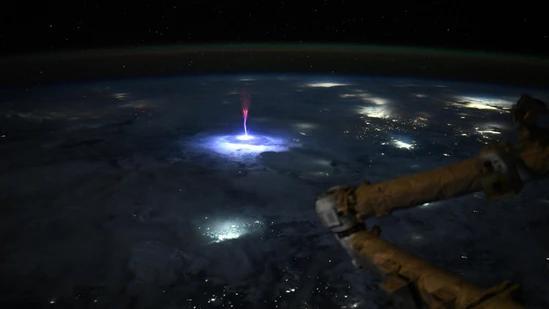
NASA Astronaut Captures Rare ‘Sprite’ Lightning Over US & Mexico
In a rare and breathtaking capture, NASA astronaut Nichole Ayers has shared a stunning image of a ‘sprite’ lightning phenomenon from the International Space Station (ISS). The photo showcases a Transient Luminous Event (TLE), a brief burst of light that occurs above thunderstorms. This unusual atmospheric phenomenon is a rare occurrence, making Ayers’ capture all the more extraordinary.
The image, taken while Ayers was orbiting above the United States and Mexico, has left scientists and space enthusiasts alike in awe. As explained by Ayers, sprites are a type of TLE that occurs when a thunderstorm reaches a certain altitude, causing a burst of energy to release a burst of light. This phenomenon is unlike traditional lightning, which is a more intense and localized event.
Ayers, a seasoned astronaut with extensive experience, shared the remarkable image on social media, stating, “Scientists can use these types of photos to better understand the relationship of TLE to thunderstorms.” Her capture has sparked excitement among researchers, who are eager to analyze the data and learn more about the dynamics of these rare events.
So, what exactly is a ‘sprite’? In simple terms, a sprite is a type of upper-atmospheric lightning that occurs above thunderstorms. Unlike traditional lightning, which is a vertical discharge of electricity, sprites are a horizontally expanding discharge that appears as a bright, glowing cloud above the storm.
Sprites are relatively rare because they require a specific combination of atmospheric conditions, including a strong thunderstorm and a layer of ice crystals in the upper atmosphere. When these conditions come together, the discharge of electricity creates a burst of light that can be seen from space.
NASA has been studying sprites and other TLEs for decades, as they provide valuable insights into the Earth’s atmosphere and the dynamics of thunderstorms. By capturing images of these rare events, researchers can gain a better understanding of the complex interactions between the atmosphere, thunderstorms, and lightning.
Ayers’ capture is not only a remarkable achievement but also an important contribution to the ongoing research into this fascinating phenomenon. Her image will likely be studied by scientists and researchers for years to come, providing valuable data and insights into the workings of the Earth’s atmosphere.
In conclusion, NASA astronaut Nichole Ayers’ capture of a rare ‘sprite’ lightning phenomenon over the United States and Mexico is a remarkable achievement that showcases the wonders of the Earth’s atmosphere. This rare event is a testament to the importance of continued research and exploration into the mysteries of our planet.
Source:






